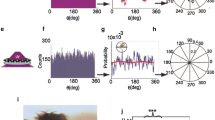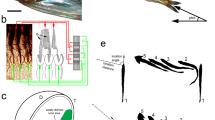Summary
-
1.
Azimuth orientation in the halfbeak fishDermogenys was studied in the laboratory to find out whether its spontaneous heading directions in a vertical beam of linearly polarized light involve perception of thee-vectorper se or merely of concomitant light intensity patterns. Responses were tested with polarized and unpolarized light as well as with either a uniform white screen horizontally surrounding the experimental vessel or with one divided into black and white alternating quadrants.
-
2.
Measured as counts within 10 °, 45 ° or 90 ° sectors through 180 ° the fish's azimuth orientation was random with unpolarized light and the white surround (Fig. 2).
-
3.
In contrast significant preferential orientation was shown in the presence of linearly polarized light and the white surround (Fig. 3). The 10 ° sector centered on the plane of vibration had the most counts (Fig. 3A). Combining the data into four sectors each 45 ° in extent makes clear a significant predominance of orientation parallel to thee-vector (Fig. 3B) as do the total counts for parallel and perpendicular quadrants (Fig. 3D).
-
4.
With the black and white quadrants combined with unpolarized light preferential orientation was clearly shown toward the light sectors (Fig. 4A, B). Since maximum differential scattering from a linearly polarized light beam is perpendicular to the plane of vibration the positive sign of this phototactic response ofDermogenys is evidence that the observed orientation parallel to thee-vector cannot also be a similar response to intensity pattern. Hence the plane of vibration must be perceived through a distinct information channel and polarotaxis is different from phototaxis.
-
5.
Tests with linear polarized light combined with the black and white surround proved that phototaxis predominated over polarotaxis under our experimental conditions and that the interaction between the two types of behavior in this case was not a simple additive one (Fig. 4C-F).
Similar content being viewed by others
References
Blaxter, J. H. S.: Visual thresholds and spectral sensitivity of herring larvae J. exp. Biol.48, 39–53 (1968)
Blaxter, J. H. S.: Brightness discrimination in larvae of plaice and sole. J. exp. Biol.57, 693–700 (1972)
Dill, P. A.: Perception of polarized light by yearling sockeye salmon. J. Fish. Res. Board Canada28, 1319–1322 (1971)
Fenwick, J. C.: Effects of pinealectomy and bilateral enucleation on the phototactic response and on conditioned response to light of the goldfish (Carassius auratus L.). Canad. J. Zool.48, 175–182 (1970)
Forward, R. B., Jr., Horch, K. W., Waterman, T. H.: Visual orientation at the water surface by the teleostZenarchopterus. Biol. Bull.143, 112–126 (1972)
Groot, C.: On the orientation of young sockeye salmon (Oncorhynchus nerka) during their seaward migration out of the lakes. Behaviour, Suppl.14, 198 pp. (1965)
Hafeez, M. A., Quay, W. B.: The role of the pineal organ in the control of phototaxis and body coloration in rainbow trout (Salmo gairdneri Richardson). Z. vergl. Physiol.68, 403–416 (1970)
Hester, F. J.: Visual contrast thresholds of the goldfish (Carassius auratus). Vision Res.8, 1315–1335 (1968)
Jander, R., Waterman, T. H.: Sensory discrimination between polarized light and light intensity patterns by arthropods. J. cell. comp. Physiol.56, 137–160 (1960)
Kleerekoper, H., Matis, J. H., Timms, A. M., Gensler, P.: Locomotor response of the goldfishCarassius auratus to polarized light and itse-vector. J. comp. Physiol. in press (1973)
Muntz, W. R. A., Northmore, D. P. M.: Vision and visual pigments in a fish,Scardinius erythriophthalmus (the rudd). Vision Res.10, 281–298 (1970)
Pang, P. K. T.: Light sensitivity of the pineal gland in blindedFundulus heteroclitus. Amer. Zoologist5, 682 (1965)
Rockwell, R. F., Seiger, M. B.: Phototaxis inDrosophila: a critical evaluation. Amer. Sci.61, 339–346 (1973)
Schmidt, W. J.: Doppelbrechung, Diohroismus und Feinbau des Außengliedes der Sehzellen vom Frosch. Z. Zellforsch.22, 485–522 (1935)
Snyder, A. W.: How fish detect polarized light. Invest. Ophthal.12, 78–79 (1973)
Strackee, L.: Dichroism in the retina at −19 °C. Vision Res.10, 925–938 (1970)
Taylor, D. H., Adler, K.: Spatial orientation by salamanders using plane polarized light. Science,181, 285–287 (1973)
Waterman, T. H.: The problem of polarized light sensitivity. (Abstr.) XV. Internat. Cong. Zool., London, 1958, Proc., p. 537–539 (1959)
Waterman, T. H.: Interaction of polarized light and turbidity in the orientation ofDaphnia andMysidium. Z. vergl. Physiol.43, 149–172 (1960)
Waterman, T. H.: Visual direction finding by fishes. In: Animal Orientation and Navigation, A Symposium (S. R. Galler, K. Schmidt-Koenig, G. J. Jacobs and R. E. Belleville, eds.) p. 437–456. Washington: N.A.S.A. (1972)
Waterman, T. H.: Specific effects of polarized light on animals In: Environmental biology (P. L. Altman and D. S. Dittmer, eds.), 2nd ed., Bethesda: Fed. Amer. Soc. Exp. Biol., in press.
Waterman, T. H.: Polarimeters in animals. In: Planets, Stars and Nebulae studied with Photopolarimetry. (T. Gehreis, ed.). Tucson: Univ. Arizona, in press (1973b)
Waterman, T. H., Forward, R. B., Jr.: Field evidence for polarized light sensitivity in the fishZenarchopterus. Nature (Lond.)288, 85–87 (1970)
Waterman, T. H., Forward, R. B., Jr.: Field demonstration of polarotaxis in the fishZenarchopterus. J. exp. Zool.180, 33–54 (1972)
Author information
Authors and Affiliations
Additional information
This research was supported by grants from the U.S. Public Health Service, The National Geographic Society and the National Aeronautics and Space Administration.
Rights and permissions
About this article
Cite this article
Forward, R.B., Waterman, T.H. Evidence forE-vector and light intensity pattern discrimination by the teleostDermogenys . J. Comp. Physiol. 87, 189–202 (1973). https://doi.org/10.1007/BF01352160
Received:
Issue Date:
DOI: https://doi.org/10.1007/BF01352160




